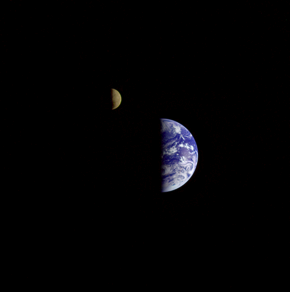Increasing Lunar Coincidences Lead to “Philosophical Disquiet”
The list of fine-tuned “coincidences” required for our unique Moon’s formation appears to be growing. The creation implications of these discoveries, including recent findings published in Nature, seem to have astronomers feeling unsettled.
Our Moon is like no other. The ratio of its mass compared to the mass of its host planet is about fifty times greater than the next closest known ratio of moon to host planet mass. Plus, our Moon orbits Earth more closely than any other known large moon orbits its host planet.
Thanks to these unique features, Earth, unlike the other solar system planets, possesses a stable rotation axis tilt, which protects it from rapid and extreme climatic variations that would otherwise rule out advanced life. The Moon also slowed Earth’s rotation rate down to the value at which advanced life could thrive and generated tides that recycle nutrients and waste efficiently.
Only recently have astronomers had any clue how such a special Moon could form. Over the past 15 years, astronomer Robin Canup has developed and improved models that demonstrate that the Moon resulted from a collision between a newly formed Earth (which, at the time, had a pervasive and very deep ocean) and a planet about twice the mass of Mars (Mars = 0.107 Earth masses). This collision took place at an impact angle of about 45 degrees and a very low impact velocity of less than 12 kilometers per second.1 In addition to forming the Moon, this highly fine-tuned event brought about three more changes, each significant for advanced life: (1) it blasted away most of Earth’s water and atmosphere;2 (2) it ejected light element material and delivered heavy elements; and (3) it transformed both the interior and exterior structure of the planet.
In a review article published in a December 2013 issue of Nature, Canup complains, “Current theories on the formation of the Moon owe too much to cosmic coincidences.”3Indeed, the required “coincidences” continue to pile up. New research reveals that the Moon has a chemical composition similar to that of Earth’s outer portions, a result that Canup’s models cannot explain—unless the total mass of the collider and primordial Earth were four percent larger than the present-day Earth, the ratio of the collider’s mass to the total mass was between 0.40 and 0.45, and a fine-tuned orbital resonance with the Sun removed the just-right amount of angular momentum from the resultant Earth-Moon system.4
Astronomers Matija Ćuk and Sarah Stewart found another way to explain the similar composition. In their model, an impactor about the mass of Mars collides with a fast-spinning (rotation rate = 2.3–2.7 hours) primordial Earth.5 The planet’s fast spin generates a disk of debris made up primarily of Earth’s own mantle material from which the Moon forms, thus accounting for the similar chemical composition. As with Canup’s most recent model, a fine-tuned orbital resonance between the Moon and the Sun is needed.
In an article published in the same issue as Canup’s recent review, Stewart concludes, “In the new giant-impact models, lunar material is derived either from a range of depths in the proto-Earth’s mantle or equally from the entire mantles of two colliding half-Earths.”6 Either way, she adds, that while “each stage of lunar evolution is plausible,” she wonders “with the nested levels of dependency in a multi-stage model, is the probability of the required sequence of events vanishingly small?”7
In her review, Canup suggests that perhaps a small collider (Mars-sized) model can be retained without so much of the added fine-tuning of the Ćuk-Stewart model if the collider’s initial chemical composition were more Earth-like rather than Mars-like. However, extra fine-tuning may be needed to explain this required initial composition.
In yet another article in the same issue of Nature, earth scientist Tim Elliott observes that the complexity and fine-tuning in lunar origin models appears to be accumulating at an exponential rate. The impact on lunar origin researchers, Elliott notes, is that “the sequence of conditions that currently seems necessary in these revised versions of lunar formation have led to philosophical disquiet.”8 What is the cause of this “philosophical disquiet”? May I submit that it stems from the fact that there is now more than sufficient evidence for the supernatural, super-intelligent design of the Earth-Moon system for humanity’s specific benefit?
Voyager 1’s 1977 Image of the Earth-Moon System
Image credit: NASA
Endnotes
- Robin M. Canup, “Dynamics of Lunar Formation,” Annual Review of Astronomy and Astrophysics 42 (September 2004): 441–75; Canup, “Lunar-Forming Collisions with Pre-Impact Rotation,” Icarus 196 (August 2008): 518–38.
- Hidenori Genda and Yutaka Abe, “Enhanced Atmospheric Loss of Protoplanets at the Giant Impact Phase in the Presence of Oceans,” Nature 433 (February 24, 2005): 842–44.
- Canup, “Lunar Conspiracies,” Nature 504 (December 5, 2013): 27.
- Canup, “Forming a Moon with an Earth-Like Composition via a Giant Impact,” Science 338 (November 23, 2012): 1052–55.
- Matija Ćuk and Sarah T. Stewart, “Making the Moon from a Fast-Spinning Earth: A Giant Impact Followed by Resonant Despinning,” Science 338 (November 23, 2012): 1047–52.
- Sarah T. Stewart, “Weak Links Mar Lunar Model,” in “Shadows Cast on Moon’s Origin,” Nature 504 (December 5, 2013): 91.
- Ibid.
- Tim Elliott, “A Chip off the Old Block,” in “Shadows Cast on Moon’s Origin,” Nature 504 (December 5, 2013): 90.






